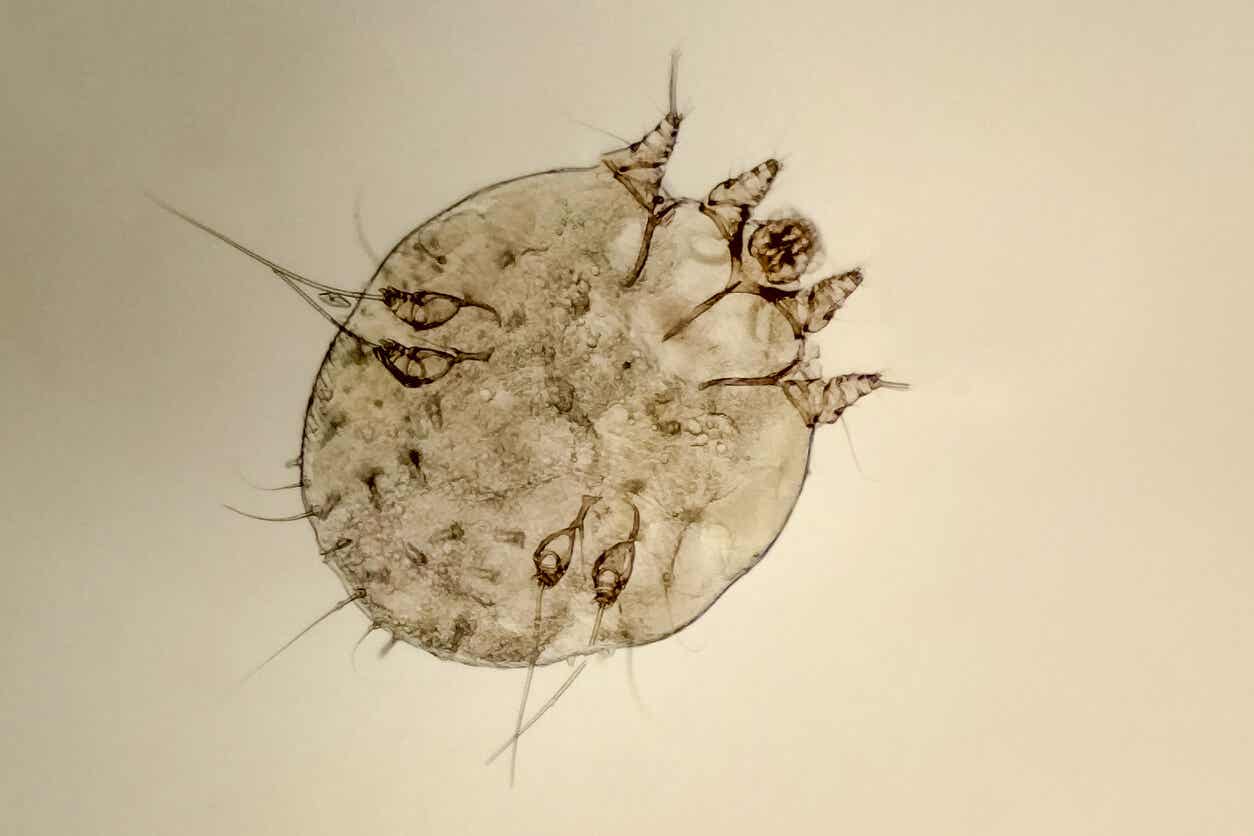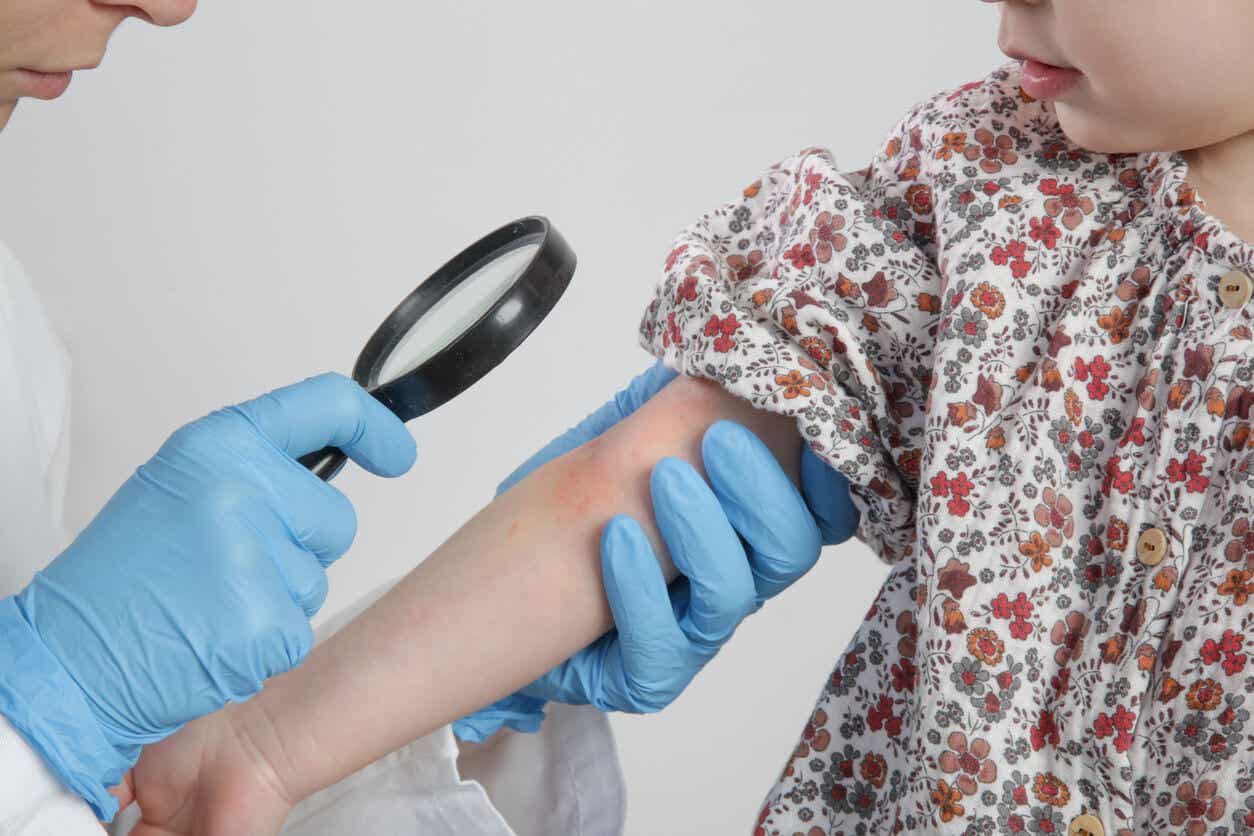Scabies in Babies: Symptoms, Causes, and Treatment


Written and verified by the dermatologist Maria del Carmen Hernandez
Scabies in babies is a very common and quite contagious skin disease. While it can affect anyone of any age, little ones are quite prone to getting it.
Those who live in crowded or poor conditions are more likely to be infected because there’s more contact between people. In fact, the elderly and young children are more likely to contract scabies because of their dependence on others for hygiene care.
Causes of scabies in infants

This parasite burrows and invades the most superficial layer of the skin (epidermis) forming a pink ‘tunnel’. Once there, it lays eggs that will soon develop into larvae, and later into new adults.
The skin of babies is thinner than that of adults and is usually more exposed to external factors. For this reason, scabies at this age usually manifests itself with greater complications, such as large blisters or pus-filled bumps.
This infection is highly contagious, as skin-to-skin contact between people is enough for the parasite to adopt a new host. Although we can see scabies at any age, it’s more frequent among children and babies in day-care centers or nurseries.
Read also: 10 Questions About Atopic Dermatitis
The symptoms of scabies in babies
The first signs of mite infection are usually multiple small, red, crusted papules on the feet and hands that may mimic insect bites or crusted pimples from scratching.
In addition, one of the most important clinical manifestations is predominantly nocturnal itching produced by an allergic reaction of the immune system to the presence of mites and eggs.
Although itching can occur all over the body, the most common locations of scabies lesions in infants include:
- Palms of the hands and soles of the feet
- Head and neck
- Trunk, legs, and arms
The biggest problem with scabies in infants is that scratching can injure the skin and cause it to become over-infected with bacteria. Therefore, infants are more likely to develop blisters, scabs, and pustules than older children or adults.
Scabies is transmitted by physical contact with an infected person. The greater the exposure, the greater the risk of infection.
How do doctors diagnose scabies?
According to a publication in the journal Pediatric Dermatology, the characteristic and distinctive lesion of scabies is the ‘tunnel’ or ‘burrow’. This lesion is so tiny and subtle that it’s often difficult to detect.
In most cases, you can observe a thin pearly line, within which you can see the mite as a small black spot.
Dermatoscopy is very useful in the doctor’s office in order to locate the burrows on the skin surface. In turn, a scraping of the skin allows doctors to examine the presence of mites, excrements, or eggs of this parasite under a microscope.

Therapeutic options for scabies in infants
The first-line treatment for scabies in infants is topical lotions that kill the causative parasite. In addition to this, calamine lotions can be used to soothe the itching.
Permethrin
Permethrin 5% is one of the treatments that doctors recommend the most due to its low toxicity. You should apply it at night and rinse it off in the morning. Then, after a week, you should repeat this procedure.
Whenever lotions, creams, or ointments are used topically, the following indications should be respected:
- Apply to the entire skin surface, from the neck downwards (including the face).
- Spread the medication under the fingernails and toenails.
- Don’t forget to apply it in all body folds (navel, between the fingers, and gluteal folds).
Lindane
Lindane 1% is often widely prescribed because of its easy availability. But because of potential neurotoxicity in young children after repeated applications, its use has been limited.
Sulfur ointment
This is applied directly to the skin for 3 consecutive nights and should be rinsed off 24 hours after the last application. Because of the great safety of its use, it’s the best option for babies, infants, and pregnant women.
Hygienic measures
While scabies requires prescription drugs to stop the infection, there are steps you can take to prevent a recurrence.
- Vacuum all furniture and carpets, then discard the vacuum bags.
- Mites are parasites that can’t survive outside the human body for more than 2 or 3 days. Therefore, you should wash all bedding, towel, and your baby’s clothing in hot water as soon as possible.
Household cohabitants and anyone who has had prolonged contact with the infected baby should also seek treatment from their respective physician.
You may be interested in: Miliaria or Sweat Rash in Infants: What Is It?
The prognosis of scabies in infants
Despite proper treatment, the signs and symptoms may persist for a few weeks before disappearing completely.
The good prognosis of this type of infection is linked to the management and treatment of the patient and their close contacts.
Scabies in babies is a very common and quite contagious skin disease. While it can affect anyone of any age, little ones are quite prone to getting it.
Those who live in crowded or poor conditions are more likely to be infected because there’s more contact between people. In fact, the elderly and young children are more likely to contract scabies because of their dependence on others for hygiene care.
Causes of scabies in infants

This parasite burrows and invades the most superficial layer of the skin (epidermis) forming a pink ‘tunnel’. Once there, it lays eggs that will soon develop into larvae, and later into new adults.
The skin of babies is thinner than that of adults and is usually more exposed to external factors. For this reason, scabies at this age usually manifests itself with greater complications, such as large blisters or pus-filled bumps.
This infection is highly contagious, as skin-to-skin contact between people is enough for the parasite to adopt a new host. Although we can see scabies at any age, it’s more frequent among children and babies in day-care centers or nurseries.
Read also: 10 Questions About Atopic Dermatitis
The symptoms of scabies in babies
The first signs of mite infection are usually multiple small, red, crusted papules on the feet and hands that may mimic insect bites or crusted pimples from scratching.
In addition, one of the most important clinical manifestations is predominantly nocturnal itching produced by an allergic reaction of the immune system to the presence of mites and eggs.
Although itching can occur all over the body, the most common locations of scabies lesions in infants include:
- Palms of the hands and soles of the feet
- Head and neck
- Trunk, legs, and arms
The biggest problem with scabies in infants is that scratching can injure the skin and cause it to become over-infected with bacteria. Therefore, infants are more likely to develop blisters, scabs, and pustules than older children or adults.
Scabies is transmitted by physical contact with an infected person. The greater the exposure, the greater the risk of infection.
How do doctors diagnose scabies?
According to a publication in the journal Pediatric Dermatology, the characteristic and distinctive lesion of scabies is the ‘tunnel’ or ‘burrow’. This lesion is so tiny and subtle that it’s often difficult to detect.
In most cases, you can observe a thin pearly line, within which you can see the mite as a small black spot.
Dermatoscopy is very useful in the doctor’s office in order to locate the burrows on the skin surface. In turn, a scraping of the skin allows doctors to examine the presence of mites, excrements, or eggs of this parasite under a microscope.

Therapeutic options for scabies in infants
The first-line treatment for scabies in infants is topical lotions that kill the causative parasite. In addition to this, calamine lotions can be used to soothe the itching.
Permethrin
Permethrin 5% is one of the treatments that doctors recommend the most due to its low toxicity. You should apply it at night and rinse it off in the morning. Then, after a week, you should repeat this procedure.
Whenever lotions, creams, or ointments are used topically, the following indications should be respected:
- Apply to the entire skin surface, from the neck downwards (including the face).
- Spread the medication under the fingernails and toenails.
- Don’t forget to apply it in all body folds (navel, between the fingers, and gluteal folds).
Lindane
Lindane 1% is often widely prescribed because of its easy availability. But because of potential neurotoxicity in young children after repeated applications, its use has been limited.
Sulfur ointment
This is applied directly to the skin for 3 consecutive nights and should be rinsed off 24 hours after the last application. Because of the great safety of its use, it’s the best option for babies, infants, and pregnant women.
Hygienic measures
While scabies requires prescription drugs to stop the infection, there are steps you can take to prevent a recurrence.
- Vacuum all furniture and carpets, then discard the vacuum bags.
- Mites are parasites that can’t survive outside the human body for more than 2 or 3 days. Therefore, you should wash all bedding, towel, and your baby’s clothing in hot water as soon as possible.
Household cohabitants and anyone who has had prolonged contact with the infected baby should also seek treatment from their respective physician.
You may be interested in: Miliaria or Sweat Rash in Infants: What Is It?
The prognosis of scabies in infants
Despite proper treatment, the signs and symptoms may persist for a few weeks before disappearing completely.
The good prognosis of this type of infection is linked to the management and treatment of the patient and their close contacts.
All cited sources were thoroughly reviewed by our team to ensure their quality, reliability, currency, and validity. The bibliography of this article was considered reliable and of academic or scientific accuracy.
- Quarterman MJ, Lesher JL Jr. Neonatal scabies treated with permethrin 5% cream. Pediatr Dermatol. 1994 Sep;11(3):264-6. doi: 10.1111/j.1525-1470.1994.tb00600.x. PMID: 7971563.
- Hurwitz S. Scabies in babies. Am J Dis Child. 1973 Aug;126(2):226-8. doi: 10.1001/archpedi.1973.02110190200019. PMID: 4125053.
- Hill TA, Cohen B. Scabies in babies. Pediatr Dermatol. 2017 Nov;34(6):690-694. doi: 10.1111/pde.13255. Epub 2017 Aug 22. PMID: 28833468.
This text is provided for informational purposes only and does not replace consultation with a professional. If in doubt, consult your specialist.








